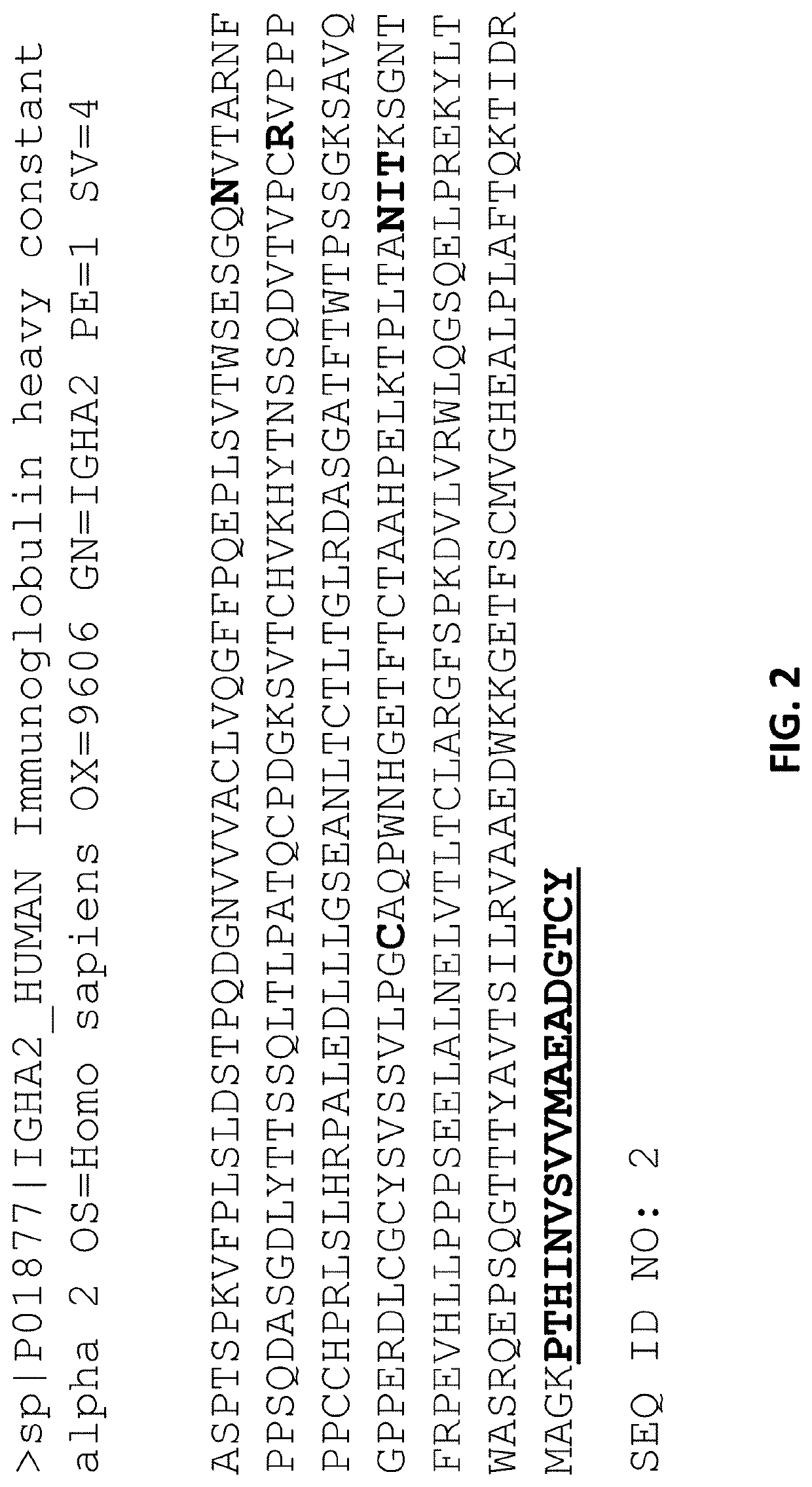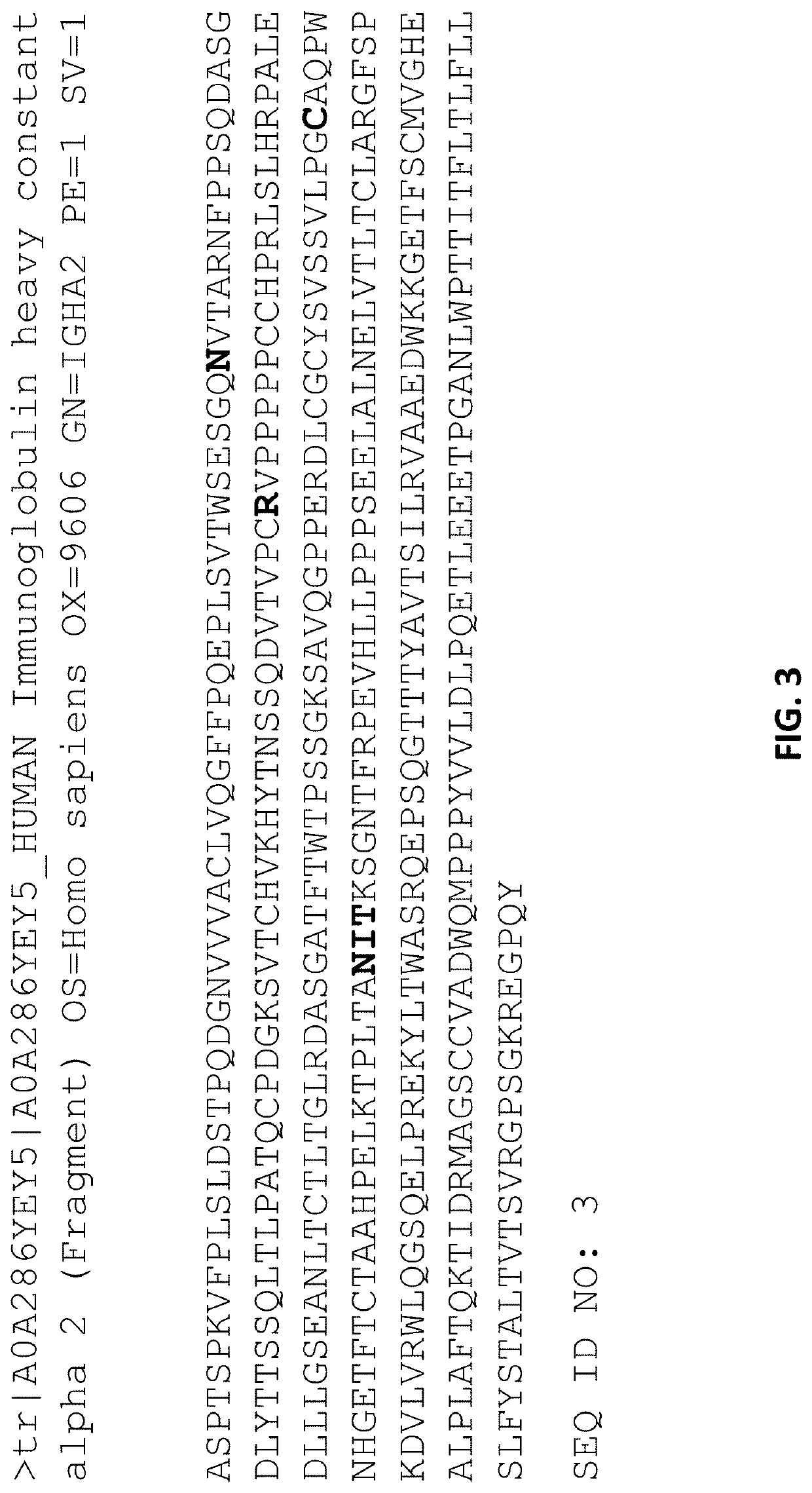Engineered iga antibodies and methods of use
a technology of iga antibodies and iga, which is applied in the field of engineered iga antibodies and methods of use, can solve the problems of insufficient clinical efficacy and side effects, especially as monotherapy, and achieve the effects of increasing antibody dependent cell mediated cytotoxicity (adcc), increasing thermostability, and reducing glycosylation
- Summary
- Abstract
- Description
- Claims
- Application Information
AI Technical Summary
Benefits of technology
Problems solved by technology
Method used
Image
Examples
example 1
d Therapeutic IgA Antibodies
[0601]A first wild type IgA2 antibody was engineered to incorporate the following amino acid substitutions and deletions: N45.2G, P124R, C86S, N114T, I115L, T116S, deletion of C147, and deletion of Y148, numbering according to IMGT scheme.
[0602]A second wild type IgA2 antibody was engineered to mutate the asparagine at position 135 to a glutamine. The N135Q mutation deletes an N-glycosylation site of the IgA2 antibody. The N135Q mutation can be combined with additional mutations of N45.2G, P124R, C86S, N114T, I115L, T116S, deletion of C147, and deletion of Y148, numbering according to IMGT scheme.
[0603]A third wild type IgA2 antibody was engineered to delete the entire tail piece, amino acids 131-148 (PTHINVSVVMAEADGTCY) (SEQ ID NO: 9). The N135 N-glycosylation site of the IgA2 antibody. The tail piece deletion can be combined with additional mutations of N45.2G, P124R, C86S, N114T, I115L, and T116S, numbering according to IMGT scheme.
[0604]Table 1 detail...
example 2
Engineered IgA Variants PGP 24,T1
[0605]Protein glycosylation plays a major role in function and serum half-life of an antibody in circulation. Incomplete glycosylation of IgA leads to clearance by dedicated receptors. The main receptor for the internalization of incompletely glycosylated proteins is the asialoglycoprotein receptor (ASGRP1). This receptor recognizes terminal galactose on N-glycosylated proteins, and is an important mediator of IgA clearance from serum. The IgA2(m1) antibody has a complicated N-linked glycosylation pattern formed by a total of 4 N-linked glycosylation sites (CH1-N45.2, CH2-N15.2, CH2-N114, CH3_CHS-N135). To enhance half-life of IgA2(m1) critical N-glycosylation motifs have been engineered to only contain either a single N-glycosylation motif or none at all. A single N-linked glycosylation site resulted in a more complete glycosylation profile increasing half-life and subsequently less antibody clearance. Yet, a fully aglycosylated IgA will not be subj...
example 3
Methods
Cloning IgA3.0 / IgA4.0
[0610]To clone the IgA3.0+ and IgA3.0 min molecules, synthetic DNA covering the entire constant region of IgA3.0 (CH1-CH2-CH3-CHS) was ordered (Baseclear, Leiden NL) and cloned in the pEE14.4 vector, replacing the IgA2(m1) sequence. In some cases of IgA3.0 min molecules, gBlocks (EDT) covering both the variable and constant regions of IgA3.0 min (VH-CH1-CH2-CH3-CHS) were cloned into the pcDNA3.4 vector. Based on the IgA3.0 min vector, IgA4.0 molecules were cloned by replacing the CH1-CH2-CH3-CHS region of IgA3.0 min in the pcDNA3.4 vector with gBlocks (EDT) containing the proper mutations for IgA4.0.
Production
[0611]For the production of the IgA3.0+ and IgA3.0 min HEK293F cells (Thermo Fisher) were used according to the manufacturer's instructions. For DNA complexing, separate vectors for IgA3.0+ or IgA3.0 min heavy chain (HC), along with vectors for kappa light chain (LC) and pAdvantage (pAdv; Promega) were mixed in optimal HC:LC:pAdv ratios and complexed...
PUM
| Property | Measurement | Unit |
|---|---|---|
| affinity | aaaaa | aaaaa |
Abstract
Description
Claims
Application Information
 Login to View More
Login to View More - R&D
- Intellectual Property
- Life Sciences
- Materials
- Tech Scout
- Unparalleled Data Quality
- Higher Quality Content
- 60% Fewer Hallucinations
Browse by: Latest US Patents, China's latest patents, Technical Efficacy Thesaurus, Application Domain, Technology Topic, Popular Technical Reports.
© 2025 PatSnap. All rights reserved.Legal|Privacy policy|Modern Slavery Act Transparency Statement|Sitemap|About US| Contact US: help@patsnap.com



